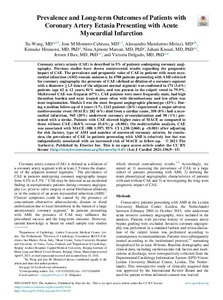Prevalence and Long-term Outcomes of Patients with Coronary Artery Ectasia Presenting with Acute Myocardial Infarction
Wang Xu; Montero-Cabezas Jose M.; Mandurino-Mirizzi Alessandro; Hirasawa Kensuke; Ajmone Marsan Nina; Knuuti Juhani; Bax Jeroen J.; Delgado Victoria
https://urn.fi/URN:NBN:fi-fe2021093048864
Tiivistelmä
Coronary artery ectasia (CAE) is described in 5% of patients undergoing coronary angiography. Previous studies have shown controversial results regarding the prognostic impact of CAE. The prevalence and prognostic value of CAE in patients with acute myocardial infarction (AMI) remain unknown. In 4788 patients presenting with AMI referred for coronary angiography the presence of CAE (defined as dilation of a coronary segment with a diameter ≥1.5 times of the adjacent normal segment) was confirmed in 174 (3.6%) patients (age 62 ± 12 years; 81% male), and was present in the culprit vessel in 79.9%. Multivessel CAE was frequent (67%). CAE patients were more frequently male, had high thrombus burden and were treated more often with thrombectomy and less often was stent implantation. Markis I was the most frequent angiographic phenotype (43%). During a median follow-up of 4 years (1-7), 1243 patients (26%) experienced a major adverse cardiovascular event (MACE): 282 (6%) died from a cardiac cause, 358 (8%) had a myocardial infarction, 945 (20%) underwent coronary revascularization and 58 (1%) presented with a stroke. Patients with CAE showed higher rates of MACE as compared to those without CAE (36.8% versus 25.6%; p <0.001). On multivariable analysis, CAE was associated with MACE (HR 1.597; 95% CI 1.238-2.060; p <0.001) after adjusting for risk factors, type of AMI and number of narrowed coronary arteries. In conclusion, the prevalence of CAE in patients presenting with AMI is relatively low but was independently associated with an increased risk of MACE at follow-up.
Kokoelmat
- Rinnakkaistallenteet [27094]
